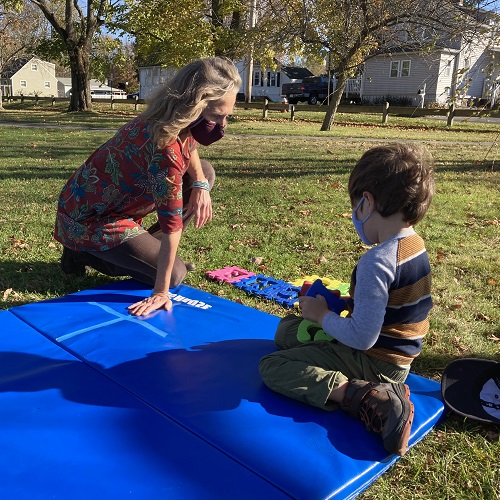As Occupational Therapy Month begins this April, Noel Kesselheim, OTR/L, has thought a lot about how the pandemic has changed both the nature of the challenges for her clients, and the ways in which the Collaborative for Educational Services’ Occupational Therapy Center (OTC) in Northampton has expanded their practice to help.
“Although it’s been stressful and challenging, our work feels more needed and more rewarding than ever.”
Families with kids of all ages have new needs. The center is also seeing more adults. There has been an increase in health care providers’ awareness of sensory processing as it relates to mental health. The OTC provides a full range of OT services, but is known for specializing in addressing sensory issues. Mental health professionals in the area are more often recognizing that sensory issues can play a role in anxiety, PTSD, and other diagnoses, and are making referrals. “Teaming with adults who are eager to explore ways to feel more comfortable in their daily lives and relationships has been very rewarding, and we’ve seen some wonderful successes.”
The pandemic has required increased flexibility in everyone’s work models, and OT is no exception.
Over the last two years, the OTC therapists (Noel Kesselheim, and Karen Figenbaum have explored and developed a wide range of new ways to provide services.
Over a four month period, they provided outdoor therapy sessions with therapy equipment brought into local parks. They have provided home visits, as well as teletherapy via zoom meetings. When finances or scheduling challenges prevented clients from accessing services in a timely way, the OTC developed a parent consult model. In this case, caregivers fill out background information, the OT reviews the information, and then meets with them virtually to provide explanations and resources, and give them some strategies and home activities.
“Initially I thought, you can’t do the work that we do remotely, it’s just not possible. But we’ve found that in many ways, we can. Not with everybody, not all the time. But surprisingly often. In some cases it’s really empowered caregivers to take a more active role, and feel confident implementing therapeutic activities on their own.”
In one case, an older couple raising their grandchild had been homeschooling due to high COVID risk factors, and weren’t comfortable coming to the office. Noel consults with them virtually once a month. She meets with the child this way, and has helped the family to set up a space for activities in the home. This 10 year old girl and her grandfather begin every homeschool day with “OT time”, which includes a variety of sensory motor activities, with academic practice like math facts and spelling woven in. “It’s been an effective model, and we plan to continue it.”
The biggest issues that have come up during the pandemic have been around self regulation and body awareness.
Children’s ability to recognize and regulate responses to group experiences has been a frequent challenge as kids return to school. Many young students lack familiarity with being in groups, and can struggle with adjusting to the structure of a school day, turn taking, sharing, etc. Another topic more caregivers ask about is children’s ability to recognize and read their bodies’ internal cues. Interoception is the awareness of internal body sensations such as hunger, thirst, need to go to the bathroom, pain, temperature, and nervous system responses to emotions. Our reactions to these sensations are strongly connected to behavior and self regulation. Sometimes children may get very wound up or distressed, but not realize they need to go to the bathroom or are experiencing hunger. More teachers and parents are seeking information about how to foster this awareness.
On the flip side, kids have demonstrated amazing flexibility in their ability to adapt to differences caused by the pandemic and masking. When asked recently “What part of your body do you use to smile,”one five year old said “eyebrows!”
Noel reflected, “That was poignant, but what an observant kid to tune into that!” At the OTC they’ve been teaching a lot about face and body cues that indicate how a person is feeling. What does a person’s posture look like when they are excited or when they are sad? Do they slouch or move around a lot? What does their voice sound like?
Working directly with educators has been another service that is on the increase for the OTC team. Many teachers, even seasoned ones, are seeking support for issues children are walking in the door with – particularly young children. This work has involved consulting with educators, co-leading groups, developing movement break activities, and providing training in programs like the zones of regulation. Regular consulting with the CES Early Childhood team began recently, a natural and exciting collaboration, so support early childhood programs and providers throughout the area.
“We’re excited by the progress and the benefits that we’re seeing.”
The Occupational Therapy Center receives referrals from providers, and school systems. Families can reach out to them as well. It begins with an intake call, to talk about what families or providers are seeing, and what types of services OT could offer to help. The areas they address include gross motor skills, fine motor skills, visual perceptual skills, ADLs, and sensory processing and self regulation..
You can learn more about the Occupational Therapy Center at www.collaborative.org/otc, or email otc@collaborative.org, and call 413.588.5279.

